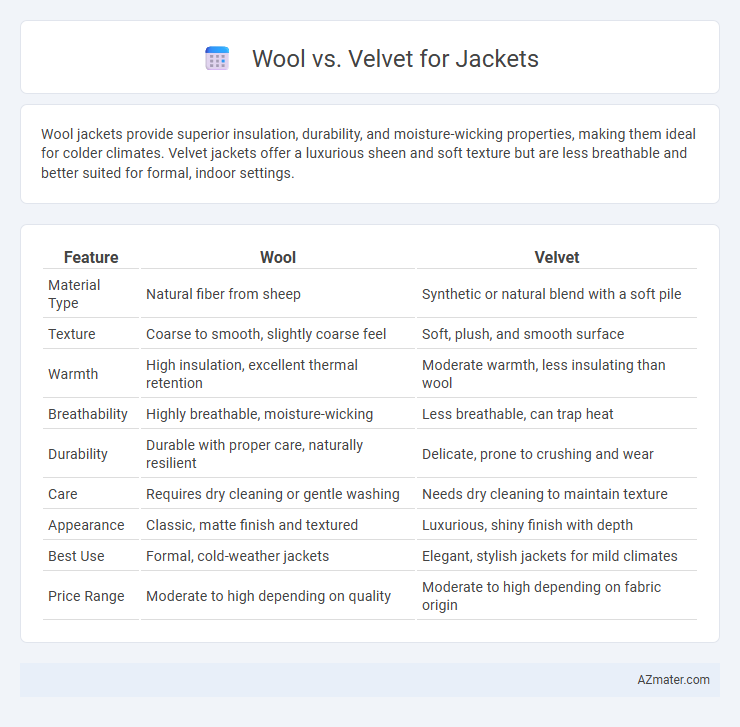Wool jackets provide superior insulation, durability, and moisture-wicking properties, making them ideal for colder climates. Velvet jackets offer a luxurious sheen and soft texture but are less breathable and better suited for formal, indoor settings.
Table of Comparison
| Feature | Wool | Velvet |
|---|---|---|
| Material Type | Natural fiber from sheep | Synthetic or natural blend with a soft pile |
| Texture | Coarse to smooth, slightly coarse feel | Soft, plush, and smooth surface |
| Warmth | High insulation, excellent thermal retention | Moderate warmth, less insulating than wool |
| Breathability | Highly breathable, moisture-wicking | Less breathable, can trap heat |
| Durability | Durable with proper care, naturally resilient | Delicate, prone to crushing and wear |
| Care | Requires dry cleaning or gentle washing | Needs dry cleaning to maintain texture |
| Appearance | Classic, matte finish and textured | Luxurious, shiny finish with depth |
| Best Use | Formal, cold-weather jackets | Elegant, stylish jackets for mild climates |
| Price Range | Moderate to high depending on quality | Moderate to high depending on fabric origin |
Introduction to Wool and Velvet Jackets
Wool jackets are renowned for their durability, natural insulation, and moisture-wicking properties, making them ideal for cold weather and formal wear. Velvet jackets, characterized by their soft texture and luxurious sheen, offer a sophisticated and elegant appearance, often favored for evening events and stylish outerwear. Both fabrics provide distinct aesthetic and functional qualities, with wool excelling in warmth and resilience, while velvet emphasizes texture and refinement.
Fabric Characteristics: Wool vs Velvet
Wool jackets offer excellent insulation, breathability, and natural moisture-wicking properties, making them ideal for cold weather. Velvet, by contrast, provides a soft, luxurious texture with a rich sheen but is less breathable and tends to trap heat, making it better suited for stylish, indoor wear. Wool fibers are more durable and wrinkle-resistant, while velvet requires careful maintenance to preserve its plush appearance.
Warmth and Insulation Comparison
Wool jackets provide superior warmth and insulation due to their natural fibers that trap heat and allow breathability, making them ideal for cold weather. Velvet, while stylish and soft, offers less insulation as it is typically made from synthetic or silk blends that do not retain heat as effectively. For maximum thermal protection in winter, wool remains the preferred material over velvet.
Comfort and Breathability Factors
Wool jackets offer superior breathability due to their natural moisture-wicking fibers, making them comfortable for extended wear in variable temperatures. Velvet, while luxurious and soft to the touch, tends to retain heat and lacks the same level of airflow, which can lead to reduced comfort during warmer conditions. Choosing wool ensures enhanced ventilation and temperature regulation, ideal for those prioritizing comfort and breathability in their outerwear.
Style and Aesthetic Appeal
Wool jackets offer a classic, structured silhouette that exudes timeless elegance, making them ideal for formal and business wear. Velvet jackets provide a rich, plush texture with a luxurious sheen that enhances evening and statement outfits, adding depth and visual interest. Choosing between wool and velvet depends on the desired style outcome: wool emphasizes refinement and warmth, while velvet highlights opulence and bold fashion sense.
Durability and Maintenance Needs
Wool jackets offer superior durability due to their natural resilience, making them resistant to wear and tear while maintaining shape over time. Velvet, with its delicate pile, requires more careful maintenance to prevent crushing and staining, often demanding professional cleaning to preserve texture and appearance. Choosing wool reduces frequent upkeep, whereas velvet requires attentive care to sustain its luxurious feel and aesthetic.
Seasonal Suitability: Which to Choose?
Wool jackets excel in colder seasons due to their natural insulation and moisture-wicking properties, making them ideal for fall and winter wear. Velvet jackets, with their soft texture and moderate warmth, suit transitional seasons like spring and cooler autumn days, providing both style and comfort. Choosing between wool and velvet depends on the climate conditions and desired level of warmth for optimal seasonal suitability.
Price and Value Considerations
Wool jackets generally offer better value due to their durability, natural breathability, and excellent insulation, often priced moderately depending on the wool grade. Velvet jackets, typically more expensive, provide luxurious texture and rich aesthetics but may require more care and be less versatile in different climates. Evaluating price against long-term wear and maintenance reveals wool as a practical investment, while velvet suits those prioritizing style and exclusivity.
Popular Occasions for Wool and Velvet Jackets
Wool jackets are favored for formal events such as business meetings, winter weddings, and outdoor ceremonies due to their warmth and classic appearance. Velvet jackets are popular choices for evening parties, holiday celebrations, and upscale social gatherings, offering a luxurious texture and elegant sheen. Both fabrics serve distinct roles, with wool excelling in cold-weather practicality and velvet providing a rich, stylish statement.
Final Verdict: Choosing the Best Jacket Material
Wool jackets offer superior warmth, breathability, and durability, making them ideal for cold climates and everyday wear, while velvet jackets provide a luxurious texture and elegant appearance suited for formal occasions. Wool's natural insulation and moisture-wicking properties outperform velvet's heavier, less breathable fabric in performance and comfort. For a versatile, long-lasting jacket, wool is the best material, whereas velvet excels in style for special events.

Infographic: Wool vs Velvet for Jacket
 azmater.com
azmater.com